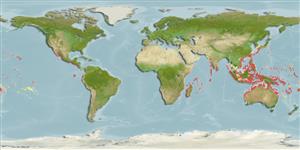Actinopterygii (ray-finned fishes) >
Beloniformes (Needle fishes) >
Hemiramphidae (Halfbeaks)
Etymology: Hemiramphus: Greek, hemi = half + Greek, rhamphos = bill, peak (Ref. 45335). More on author: Valenciennes.
Environment / Climate / Range
Ecology
Marine; brackish; reef-associated; depth range 0 - ? m. Tropical, preferred ?
Pacific Ocean: ranging eastward to the Gilbert Islands and Samoa, north to southern Japan. Confused with Hemiramphus archipelagicus under the name Hemiramphus marginatus by many authors (Ref. 10943).
Length at first maturity / Size / Weight / Age
Maturity: Lm ?, range 22 - 23.6 cm
Max length : 40.0 cm SL male/unsexed; (Ref. 54980); common length : 25.0 cm SL male/unsexed; (Ref. 9843)
Dorsal
spines
(total): 0;
Dorsal
soft rays
(total): 12-15;
Anal
spines: 0;
Anal
soft rays: 10 - 13;
Vertebrae: 52 - 57. Greatly prolonged, beak-like lower jaw; upper jaw short, triangular and without scales; preorbital ridge absent; total number of gill rakers on first gill arch 33-46; pectoral fins long, reaching beyond anterior margin of nasal pit when folded forward; no spots or vertical bars on sides.
Inhabits coastal waters rich in vegetation (Ref. 5213). Found more offshore than other species of Hemiramphus in the western central Pacific; juveniles and immature individuals are relatively common far from shore, usually among floating plants (Ref. 9843). Caught by set-net.
Life cycle and mating behavior
Maturity | Reproduction | Spawning | Eggs | Fecundity | Larvae
Collette, B.B. and J. Su, 1986. The halfbeaks (Pisces, Beloniformes, Hemiramphidae) of the Far East. Proc. Acad. Nat. Sci. Philadelphia 138(1):250-301. (Ref. 10943)
IUCN Red List Status (Ref. 115185)
CITES (Ref. 94142)
Not Evaluated
Threat to humans
Harmless
Human uses
Fisheries: minor commercial
More information
ReferencesAquacultureAquaculture profileStrainsGeneticsAllele frequenciesHeritabilityDiseasesProcessingMass conversion
Tools
Special reports
Download XML
Internet sources
Estimates of some properties based on models
Phylogenetic diversity index (Ref.
82805): PD
50 = 0.5005 [Uniqueness, from 0.5 = low to 2.0 = high].
Trophic Level (Ref.
69278): 3.4 ±0.5 se; Based on size and trophs of closest relatives
Resilience (Ref.
69278): High, minimum population doubling time less than 15 months (Preliminary K or Fecundity.).
Vulnerability (Ref.
59153): Low to moderate vulnerability (30 of 100) .
